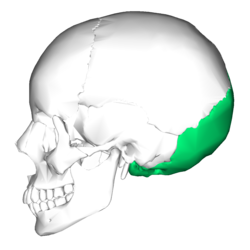Exoccipital condyles
| Occipital bone | |
|---|---|

Human skull (Occipital bone is at bottom right).
|
|

Position of occipital bone (shown in green)
|
|
| Details | |
| Articulations | the two parietals, the two temporals, the sphenoid, and the atlas |
| Identifiers | |
| Latin | os occipitale |
| TA | A02.1.04.001 |
| FMA | 52735 |
|
Anatomical terms of bone
[]
|
|
The occipital bone (/ˌɒkˈsɪpɪtəl/) is a cranial dermal bone, and is the main bone of the occiput (back and lower part of the skull). It is trapezoidal in shape and curved on itself like a shallow dish. The occipital bone overlies the occipital lobes of the cerebrum. At the base of the skull in the occipital bone there is a large oval opening called the foramen magnum, which allows the passage of the spinal cord.
Like the other cranial bones it is classed as a flat bone. Due to its many attachments and features the occipital bone is described in terms of separate parts. From its front to the back is the basilar part, at the sides of the foramen magnum are the lateral parts, and the back is named as the squamous part.
The basilar part is a thick, somewhat quadrilateral piece in front of the foramen magnum and directed towards the pharynx. This is also called the basioccipital.
The lateral parts of the occipital bone are on either side of the foramen magnum and these are also called the exoccipitals.
The squamous part is the curved, expanded plate behind the foramen magnum and is the largest part of the occipital bone.
The occipital bone, like the other cranial bones, has outer and inner layers (also called plates or tables) of cortical bone tissue between which is the cancellous bone tissue known in the cranial bones as diploë. The bone is especially thick at the ridges, protuberances, condyles, and anterior part of the basilar part; in the inferior cerebellar fossae it is thin, semitransparent, and without diploë.
...
Wikipedia
